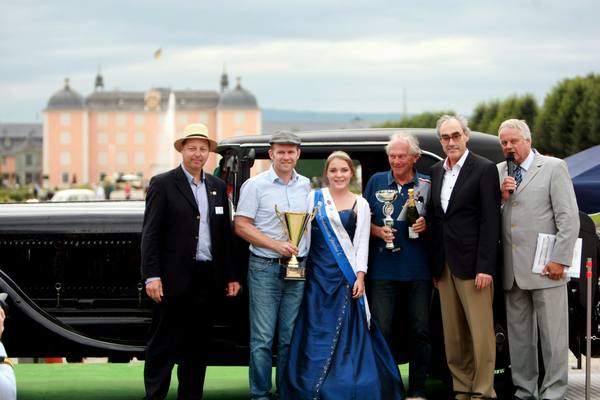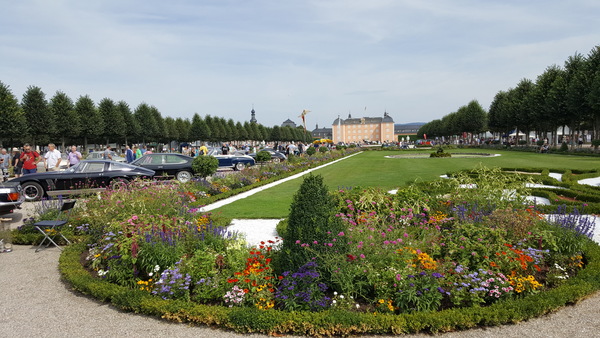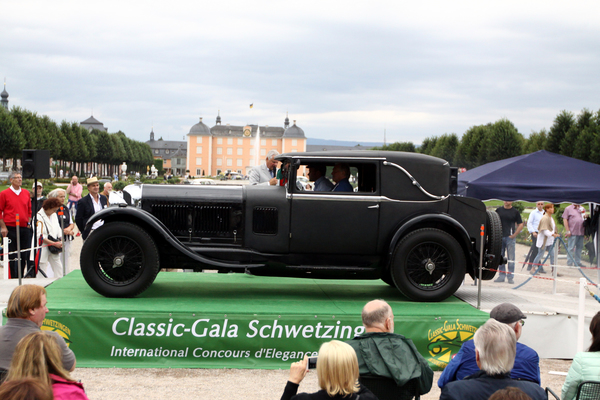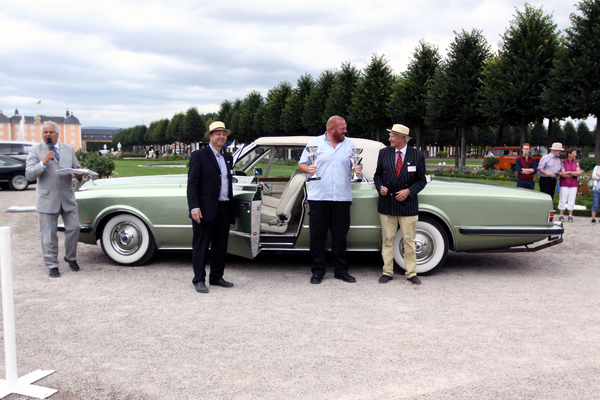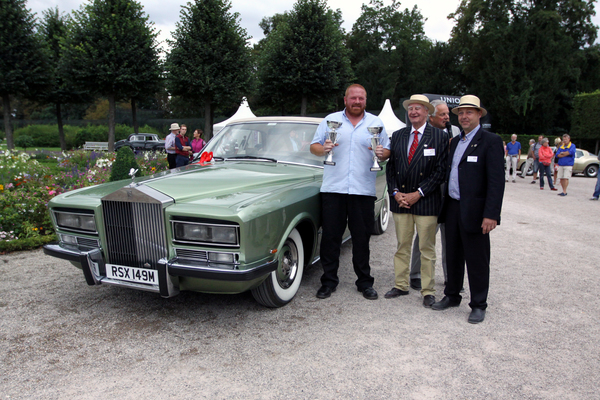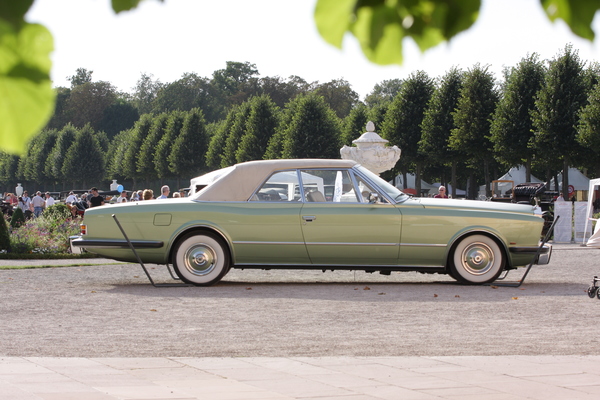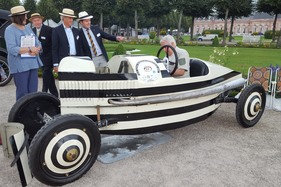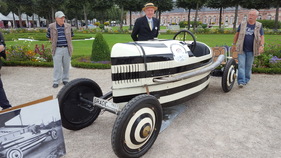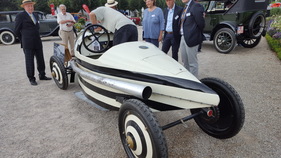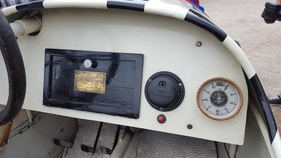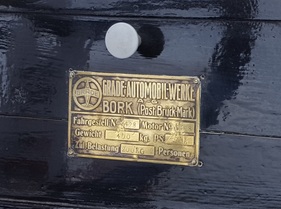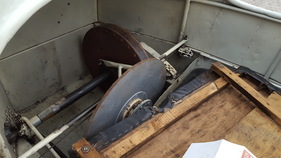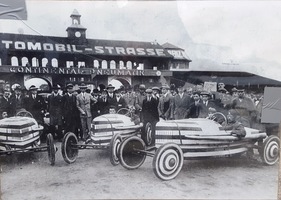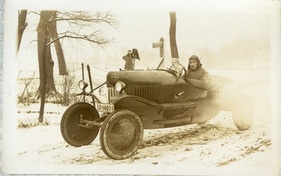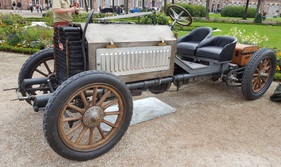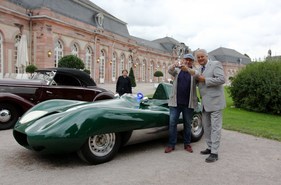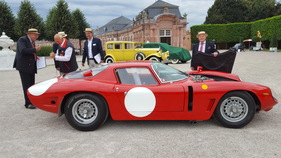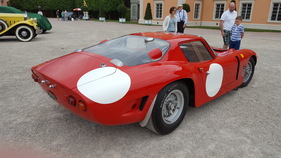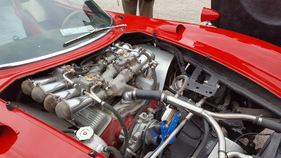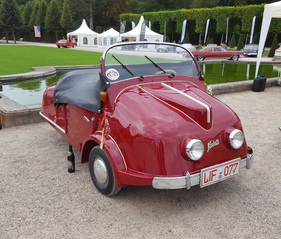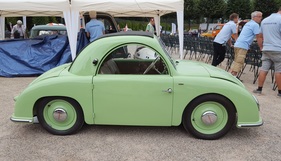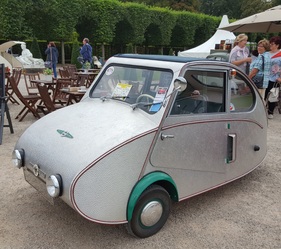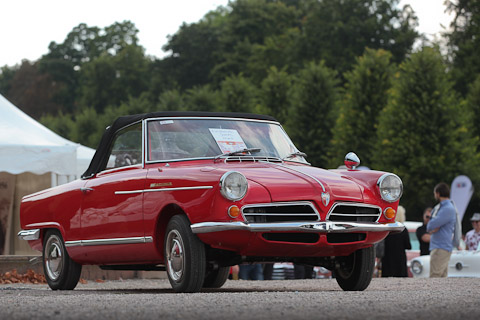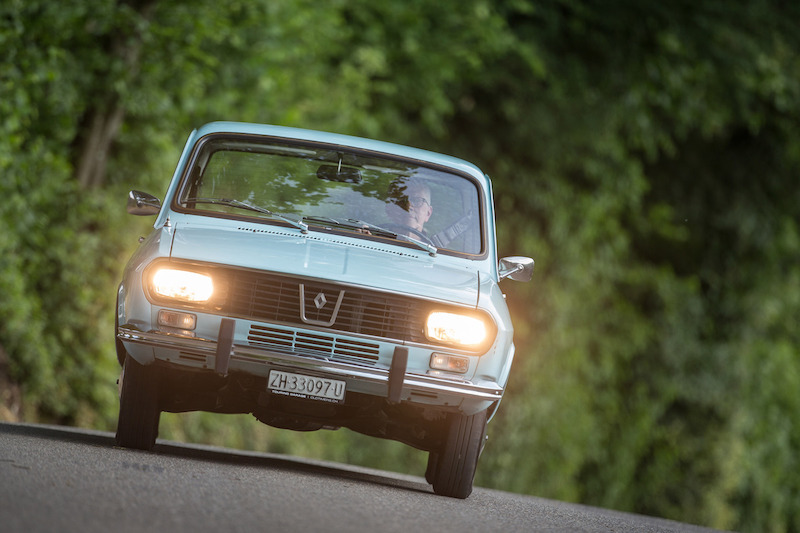"Pebble Beach is coming to Germany and the judges are being flown in from there" - this or something similar was how the 1st European Concours d'Elegance in Schwetzingen was announced.
That was in 2001, and Johannes Hübner was already there. In fact, the field of participants was not dissimilar to the US model and brought together automotive treasures and works of art from the Talbot Teardrop and Lancia D 50 to the last built - and real - Blitzen Benz against the backdrop of Schwetzingen Palace.

The Concours was held for two more years under the direction of the British Bob Gathercole, before being handed over to Johannes Hübner via the organizer AvD and this year, from 2 to 4 September 2016, the 12th edition will be held as the Classic Gala.
Initially, Pebble Beach was the big role model, but Johannes Hübner has managed to develop the field of participants into a cross-section of automotive history, which this year ranged from the Benz 1893 to the Isdera Autobahn Kurier from 2006.
The author of these lines was there for the first time in 2001 and for the 2016 edition. At every Concours and every year, the question of the most important exhibit arises for the automobile historian. This was easily answered in 2001 with the only existing and largely unrestored Blitzen Benz - the example in the Mercedes Museum was assembled from parts in the 1930s.
The "Kleine Grade" as a milestone in automotive history
What was it like in 2016? Well, it was very easy then too. Because with the "Kleine Grade", in a sports version and with Avus participation, a piece of automotive history was present, of which the author previously only knew the example in the German Technical Museum Berlin and which deserves to be honored here by the designer Hans Grade and a closer look at its construction.

Hans Grade (* May 17, 1879 † October 22, 1946) made his first flight in Magdeburg on October 28, 1908, which only went over 100 m and ended in a crash landing, but placed him in the group of aviation pioneers. Grade remained loyal to aircraft development and was therefore an important part of the German air force during the First World War.
After the end of the war and due to the Treaty of Versailles, no airplanes were allowed to be produced in Germany for many years. However, this did not apply to automobiles. If we look at the cars of the early 1920s, they were large, heavy and expensive. What was missing was a small, light and affordable car.
And that was what Hans Grade had in mind with his design. Although we do not know how Grade came up with the idea of the floor pan as the first self-supporting body and the friction wheel drive, we can assume that he was familiar with the advantages of low weight, or lightweight construction, from aviation.
Let's take a closer look at the implementation of Grade's ideas. One visually striking and acoustically unmistakable example was among the participants, proudly presented by R. Aust from Borkheide, the former Bork, where the vehicles were manufactured in a small factory.
The body shape is clearly derived from aircraft construction. The special feature is the sheet steel floor pan that supports the chassis and extends to the seam under the exhaust. The spring mount, which has to transfer all acceleration, braking and lateral forces to the car body, is attached with a strong rivet.
The teardrop shape of the floor pan provides additional rigidity and an aerodynamic advantage due to the closed underside, in addition to the weight reduction compared to the ladder frame commonly used at the time. The wheels are designed as disks for the same reason.
Hans Grade's second ingenious idea was the friction gearbox, which not only saved weight compared to the manual gearbox, but also costs. In keeping with the times, Grade had an affordable small car in mind and dispensed with all components that did not serve motorized locomotion, including a differential in addition to the conventional gearbox. With a track width of 1000 mm, the disadvantage of a slightly spinning inner wheel when cornering could be accepted. The rigid rear axle is driven by a chain.
The cardan shaft guided through the cockpit is rigidly connected to the flywheel, which is positioned transverse to the direction of travel, i.e. as long as the engine is running, the flywheel rotates. Perpendicular to the flywheel is the friction wheel, which is pressed against the flywheel by means of a spring. The "gearshift" is located on the left-hand side of the cockpit and moves the friction wheel on the flywheel from the center (idle) to the outside (high gear). The friction wheel shaft acts on the gear wheel located outside the body, from where the rigid rear axle is driven by a chain. Advantages: simple and cheap to manufacture and low weight.
Moving on to the engine, we find an air-cooled 2-cylinder two-stroke engine of 859 cc and an output of 16 hp in the front section, 20 hp in the sports version. Once again, inexpensive production and weight savings thanks to air cooling. The air is sucked in through the front slots and led out again through the side slots. The engine is started manually by a flywheel lever located on the cardan shaft.
Interesting and also derived from aircraft construction is the steering by means of chain and wire ropes.
The steering wheel, mounted vertically in front of the driver, acts on a horizontal shaft on which a gearwheel sits in the engine compartment, which transmits the steering movements to the cables to the front axle via a four-row chain. The chassis consists of a rigid front and rear axle, guided on leaf springs, the foot brake acts on the rear wheels, a second brake acts on the shaft of the friction wheel.
The dashboard is just as spartan as the rest of the car and contains the Bosch ignition lock with light switch and a speedometer from the Berlin company Deuta in addition to the type plate. The nameplate lists the manufacturer as Grade Automobilwerke AG in Bork (now Borkheide), the chassis number 428, could also be 1428 as it is slightly damaged, only the last digit of the engine number is recognizable as 8.
The weight of the ready-to-drive car is only 400 kg, the payload is given as 200 kg, the engine output as 16 hp. According to Seher-Thoss "Die Deutsche Automobil Industrie", it was 20 hp in the sports version.
If we look at the car in comparison with its direct competitor, the Hanomag 2/10 PS, better known as the Kommissbrot, we can see the similarities in the minimalist two-seater, engine capacity of less than one liter, the manual starter and the rigid rear axle. While the Grade had a two-stroke front engine, the Hanomag had a four-stroke rear engine.
The main difference, however, can be seen in the capitalization of the two AGs. While Hannoversche Maschinenbau AG had a capitalization of 14.5 million when it converted to gold marks in 1925, Grade AG had a capitalization of just 0.246 million, which may ultimately have led to Grade's demise.
Due to the early conversion to assembly line work, Hanomag was also able to produce much more cheaply than the Grade factories, which largely operated on a manufacturing basis. And this was reflected both in the sales price and in the quantities produced. According to Seherr-Thoss, the Komissbrot was offered for 1850 Reichsmark, the Grade for 2500.
The Grade was built from 1921 to 1925 in 1500 to 2000 units - the figures vary.
The "Kleine Grade" was described in detail and quite positively in the trade press, e.g. in 1923 in issue 29/30 of the trade journal "Der Motorwagen" by Paul Kahn, engineer and factory owner, who, in addition to a technical description, emphasized a trouble-free journey from Berlin to Karlsruhe - naturally on country roads.
Both companies, Grade and Hanomag, took part in sporting events, be it reliability or off-road driving ...
... be it circuit races like the one on the Avus in 1925, from which the following photo was taken.
In its practical application, the friction wheel drive is of course limited to small engines and lower power ratings, so it is not surprising that it did not become established in the subsequent period as engine power ratings increased.
Why the brilliant idea of the self-supporting body fell into oblivion until Opel brought it to production maturity in a slightly modified form with the Opel Olympia in 1936 is a mystery of automotive history that remains unexplained to this day, similar to the mid-engine installed by Porsche from 1934, which took even longer to be installed in a Formula 1 car by John Cooper in 1959.
You could say: good things take time.
A beauty contest, of course
Despite the almost exotic Grade, which caused many a technology fan to ponder, the Concours d'Elégance, which also shone with beautiful and interesting cars in 2016, should not be forgotten. In the end, the Grade won the jury's prize of honor.

A Bentley Speed from 1929 was voted "Best of Show". The Mercedes-Benz Nürburg 500 from 1931 by the Winet brothers from Switzerland and the Studebaker Lark VIII from 1960 were narrowly beaten.
The category winners were:
- FIVA Class A (up to 1904)
Oldsmobile Curved Dash from 1903 - FIVA Class B (1905-1918)
Rochet Schneider 25 CV - FIVA Class C (1919-1930)
Bentley Speed 6 from 1929 - FIVA Class D (1931-1945)
Mercedes-Benz 500 Nürburg from 1931 - FIVA Class E (1946-1960)
Mercedes-Benz 300 S Roadster from 1953 - FIVA Class F (1961-1970)
Iso A3C from 1965 - FIVA Class G (1971-1990)
Rolls-Royce Silver Shadow II from 1978 - Class H - best original
Studebaker Lark VIII from 1960 - Class I - badge of honor Pierce Arrow
Pierce Arrow 836 Coupé from 1936 - Class O - best self-restoration
Mercedes-Benz 170 V from 1937 - Star of Classic-Gala Schwetzingen
Rolls-Royce Phantom VI Cabriolet Frua 1973 - Grand Prix of the public
De Dion Bouton Grand Prix from 1908
There were also countless other prizes and awards, all of which are listed on the Classic Gala website .

Among the small cars, which also caused a lot of delight in 2016, the winner was a Gutbrod from 1955, followed by the BMW 600 with caravan and an NSU Fiat Belvedere from 1958.
However, the prize for the best original condition was won by a 1960 Studebaker Lark VIII limousine, which proves that good care can be a guarantee for the future.
Lots of attractions and a little rain
The approximately 18,500 spectators at the 12th Classic Gala had to endure a little rain, but they were rewarded with magnificent cars and a few surprises, such as the rear-engined Moretti Sportiva restored by the owner himself, which juror Peter Kaus once had in his Rosso Bianco collection.
A defilée of 20 Jaguars celebrated the milestones of the British luxury brand and more than 30 exclusive Rolls Royces built between 1929 and 2010 demonstrated the diversity of the sibling brands Rolls Royce and Bentley. Mercedes-Benz I.G. honored the 60th anniversary of the exclusive Type 220 S and SE as Ponton Coupé and Cabriolet with another special show.
A 1951 Mercury was a star of the 4th USCCC, the only international competition for original US vehicles in Germany. A 1930 Ford A Coupé won the concours among the 50 participants, just ahead of a '57 Cadillac Eldorado Biarritz with a stainless steel roof, which was named "Best of Fifties". The best pre-war car was a Packard 8-120 Convertible from 1935, ahead of the impressive Stanley Steamer steam car from 1919.
The future of the Classic Gala is secured by multi-year agreements with the Automobile Club of Germany (AvD) and Württembergische Versicherung, as well as other well-known partners - the organizers are already planning the 13th edition on 1 to 3 September 2013, for which many renowned participants from all over Europe have already confirmed their attendance.

